1. What is a Database?
A database is a structured collection of data stored electronically, designed to facilitate easy access, management, and updating of that data. You can think of it as a digital filing system where information is organized into tables, making it efficient to retrieve the data you need.
Diagram
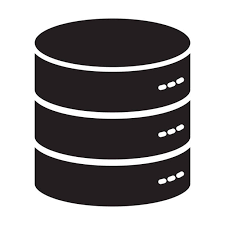
Key Components of a Database:
- Data: This refers to raw information, such as names, addresses, or transaction details.
- Tables: A database consists of tables that resemble spreadsheets, organized into rows and columns. Each row represents a record (an individual entry), while each column represents a field (a specific piece of information about that entry).
- DBMS:A Database Management System (like MySQL, PostgreSQL, or Oracle) provides the tools to create, read, update, and delete data within the database.
2. What is a Relationship?
In general terms, a relationship refers to a connection or association between two or more entities. In the context of databases, relationships define how data in one table relates to data in another. These relationships are essential for organizing and structuring data across multiple tables, helping to avoid redundancy (duplicated data) and enhancing data integrity.
Example of Notations:
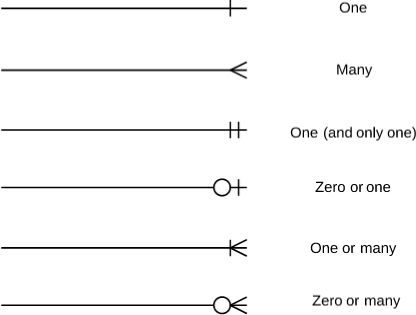
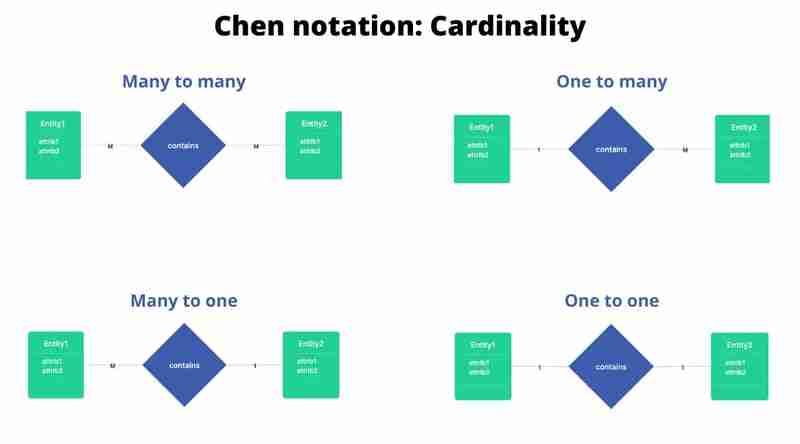
3. Types of Database Relationships
A database relationship is a defined connection between two tables, specifying how records in one table relate to records in another. There are three primary types of database relationships:
3.1 One-to-One Relationship
In a one-to-one relationship, each record in Table A corresponds to a single record in Table B, and vice versa. This type of relationship is often used when two tables contain different types of information about the same entity.
Example: Each person has only one passport, and each passport is assigned to only one person.
Schema Diagram:
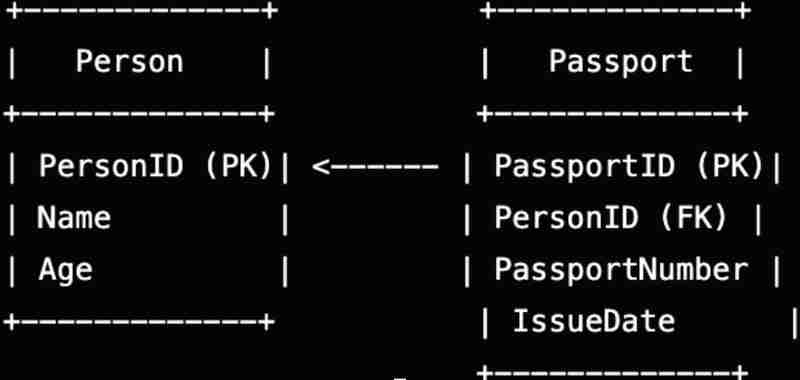
Notable Points:
Foreign Key Placement: The PersonID is included in the Passport table instead of the Passport ID in the Person table because the passport is dependent on the person. If a person exists, the passport exists; a profile doesn’t make sense without a user. The table that has the dependency contains the foreign key.
Direction of the Relationship: The arrow in database relationship diagrams indicates which table contains the foreign key that references the other. When reading a one-to-one relationship in a database schema, starting from the foreign key (FK) side often provides clearer context.
Table Representation
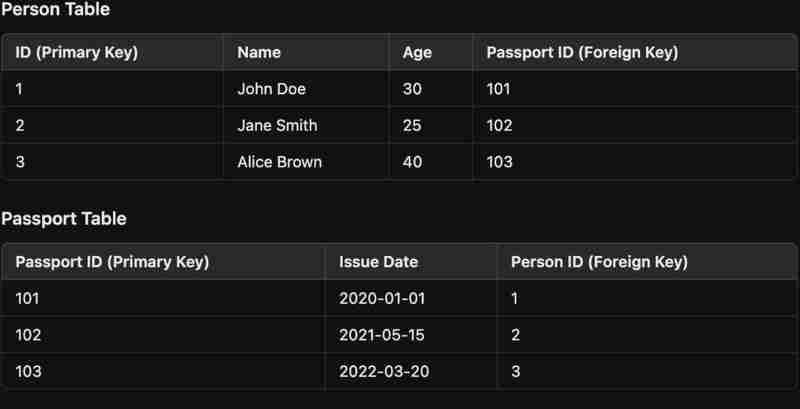
Golang Struct Details

3.2 One-to-Many Relationship
A one-to-many relationship occurs when a single record in one table (the "one" side) can be associated with multiple records in another table (the "many" side). However, each record in the "many" table is linked back to only one record in the "one" table.
Example: One user can create multiple posts. Each post will reference a single user, establishing a one-to-many relationship between the Users and Posts tables.
Schema Diagram
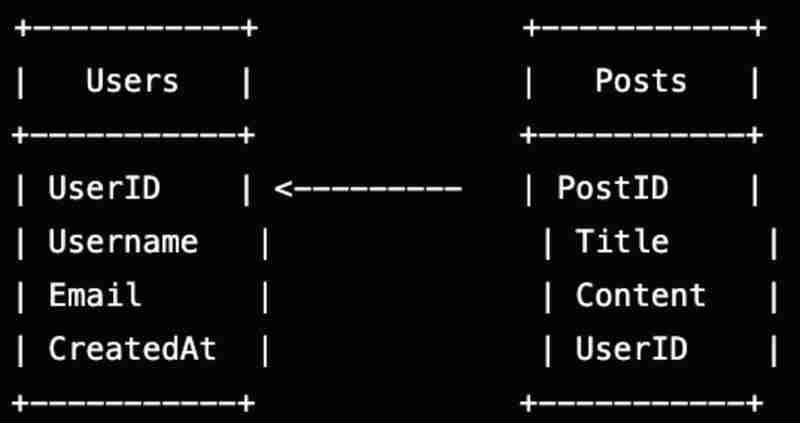
Characteristics:
- Single Entity: The "one" side represents a single entity.
- Multiple Associations: The "many" side consists of multiple entities associated with that single entity.
-
Foreign Key: The "many" table contains a foreign key referencing the primary key of the "one" table.
Table Representation
 GoLang Struct
GoLang Struct
 3.3 Many-to-Many Relationship
3.3 Many-to-Many Relationship
In a many-to-many relationship, multiple records in one table can be associated with multiple records in another table. This relationship is typically implemented using a junction (or join) table that holds foreign keys referencing the primary keys of both tables.
Schema Diagram
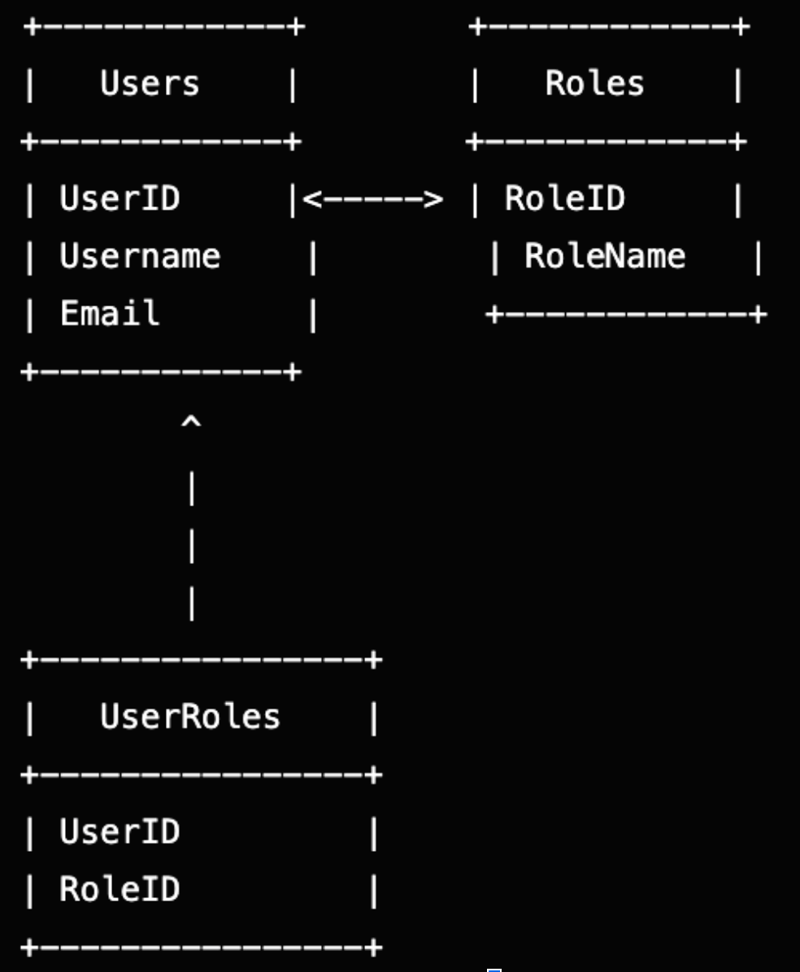
Example Without a Junction Table:
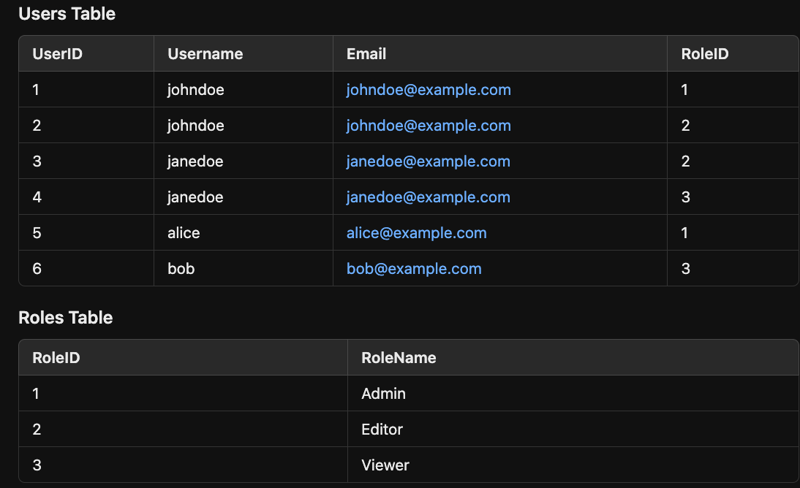
Drawbacks of Not Using a Junction Table
- Data Redundancy You may need to duplicate data across multiple rows, leading to inconsistencies and increased storage requirements.
- Limited Flexibility: Not using a junction table restricts your ability to store additional attributes about the relationship itself (e.g., timestamps or status), complicating queries and reducing the richness of your data model.
Benefits of Using a Junction Table:
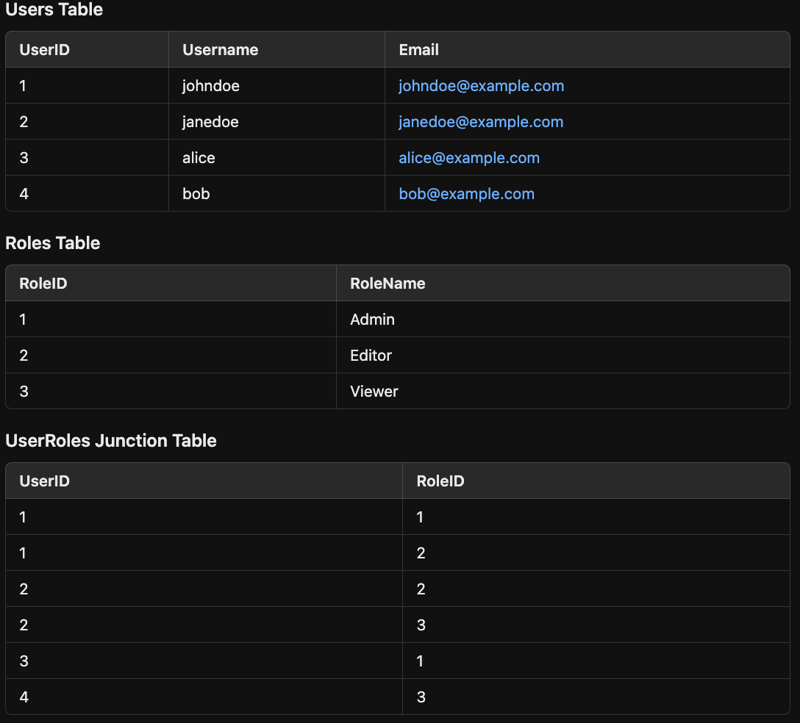
- Reduced Redundancy: The Users and Roles tables are free from redundancy. Each user and each role is stored only once.
- Clear and Manageable Relationships: The junction table clearly defines the many-to-many relationships without confusion. It simplifies the process of adding or removing roles for users. GoLang Struct Representation
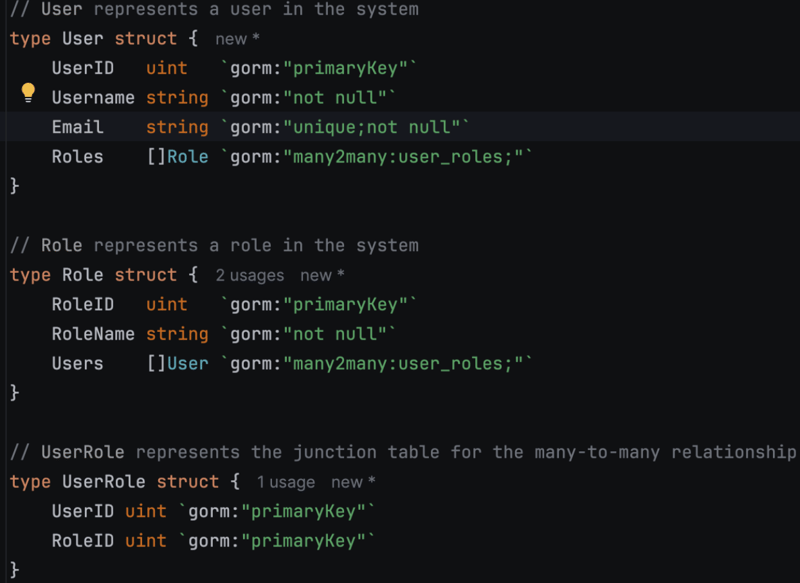
When and Why Table
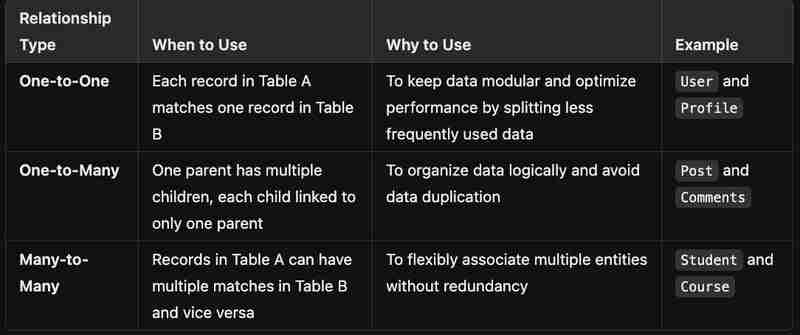
The above is the detailed content of Understanding Databases and Their Relationships. For more information, please follow other related articles on the PHP Chinese website!

Hot AI Tools

Undress AI Tool
Undress images for free

Undresser.AI Undress
AI-powered app for creating realistic nude photos

AI Clothes Remover
Online AI tool for removing clothes from photos.

Clothoff.io
AI clothes remover

Video Face Swap
Swap faces in any video effortlessly with our completely free AI face swap tool!

Hot Article

Hot Tools

Notepad++7.3.1
Easy-to-use and free code editor

SublimeText3 Chinese version
Chinese version, very easy to use

Zend Studio 13.0.1
Powerful PHP integrated development environment

Dreamweaver CS6
Visual web development tools

SublimeText3 Mac version
God-level code editing software (SublimeText3)

Hot Topics
 What are the implications of Go's static linking by default?
Jun 19, 2025 am 01:08 AM
What are the implications of Go's static linking by default?
Jun 19, 2025 am 01:08 AM
Go compiles the program into a standalone binary by default, the main reason is static linking. 1. Simpler deployment: no additional installation of dependency libraries, can be run directly across Linux distributions; 2. Larger binary size: Including all dependencies causes file size to increase, but can be optimized through building flags or compression tools; 3. Higher predictability and security: avoid risks brought about by changes in external library versions and enhance stability; 4. Limited operation flexibility: cannot hot update of shared libraries, and recompile and deployment are required to fix dependency vulnerabilities. These features make Go suitable for CLI tools, microservices and other scenarios, but trade-offs are needed in environments where storage is restricted or relies on centralized management.
 How does Go ensure memory safety without manual memory management like in C?
Jun 19, 2025 am 01:11 AM
How does Go ensure memory safety without manual memory management like in C?
Jun 19, 2025 am 01:11 AM
Goensuresmemorysafetywithoutmanualmanagementthroughautomaticgarbagecollection,nopointerarithmetic,safeconcurrency,andruntimechecks.First,Go’sgarbagecollectorautomaticallyreclaimsunusedmemory,preventingleaksanddanglingpointers.Second,itdisallowspointe
 How do I create a buffered channel in Go? (e.g., make(chan int, 10))
Jun 20, 2025 am 01:07 AM
How do I create a buffered channel in Go? (e.g., make(chan int, 10))
Jun 20, 2025 am 01:07 AM
To create a buffer channel in Go, just specify the capacity parameters in the make function. The buffer channel allows the sending operation to temporarily store data when there is no receiver, as long as the specified capacity is not exceeded. For example, ch:=make(chanint,10) creates a buffer channel that can store up to 10 integer values; unlike unbuffered channels, data will not be blocked immediately when sending, but the data will be temporarily stored in the buffer until it is taken away by the receiver; when using it, please note: 1. The capacity setting should be reasonable to avoid memory waste or frequent blocking; 2. The buffer needs to prevent memory problems from being accumulated indefinitely in the buffer; 3. The signal can be passed by the chanstruct{} type to save resources; common scenarios include controlling the number of concurrency, producer-consumer models and differentiation
 How can you use Go for system programming tasks?
Jun 19, 2025 am 01:10 AM
How can you use Go for system programming tasks?
Jun 19, 2025 am 01:10 AM
Go is ideal for system programming because it combines the performance of compiled languages ??such as C with the ease of use and security of modern languages. 1. In terms of file and directory operations, Go's os package supports creation, deletion, renaming and checking whether files and directories exist. Use os.ReadFile to read the entire file in one line of code, which is suitable for writing backup scripts or log processing tools; 2. In terms of process management, the exec.Command function of the os/exec package can execute external commands, capture output, set environment variables, redirect input and output flows, and control process life cycles, which are suitable for automation tools and deployment scripts; 3. In terms of network and concurrency, the net package supports TCP/UDP programming, DNS query and original sets.
 What are functional options patterns in Go, and when are they useful for constructor design?
Jun 14, 2025 am 12:21 AM
What are functional options patterns in Go, and when are they useful for constructor design?
Jun 14, 2025 am 12:21 AM
FunctionaloptionsinGoareadesignpatternusedtocreateflexibleandmaintainableconstructorsforstructswithmanyoptionalparameters.Insteadofusinglongparameterlistsorconstructoroverloads,thispatternpassesfunctionsthatmodifythestruct'sconfiguration.Thefunctions
 How do I call a method on a struct instance in Go?
Jun 24, 2025 pm 03:17 PM
How do I call a method on a struct instance in Go?
Jun 24, 2025 pm 03:17 PM
In Go language, calling a structure method requires first defining the structure and the method that binds the receiver, and accessing it using a point number. After defining the structure Rectangle, the method can be declared through the value receiver or the pointer receiver; 1. Use the value receiver such as func(rRectangle)Area()int and directly call it through rect.Area(); 2. If you need to modify the structure, use the pointer receiver such as func(r*Rectangle)SetWidth(...), and Go will automatically handle the conversion of pointers and values; 3. When embedding the structure, the method of embedded structure will be improved, and it can be called directly through the outer structure; 4. Go does not need to force use getter/setter,
 What are interfaces in Go, and how do I define them?
Jun 22, 2025 pm 03:41 PM
What are interfaces in Go, and how do I define them?
Jun 22, 2025 pm 03:41 PM
In Go, an interface is a type that defines behavior without specifying implementation. An interface consists of method signatures, and any type that implements these methods automatically satisfy the interface. For example, if you define a Speaker interface that contains the Speak() method, all types that implement the method can be considered Speaker. Interfaces are suitable for writing common functions, abstract implementation details, and using mock objects in testing. Defining an interface uses the interface keyword and lists method signatures, without explicitly declaring the type to implement the interface. Common use cases include logs, formatting, abstractions of different databases or services, and notification systems. For example, both Dog and Robot types can implement Speak methods and pass them to the same Anno
 How do I use the io package to work with input and output streams in Go?
Jun 20, 2025 am 11:25 AM
How do I use the io package to work with input and output streams in Go?
Jun 20, 2025 am 11:25 AM
TheGoiopackageprovidesinterfaceslikeReaderandWritertohandleI/Ooperationsuniformlyacrosssources.1.io.Reader'sReadmethodenablesreadingfromvarioussourcessuchasfilesorHTTPresponses.2.io.Writer'sWritemethodfacilitateswritingtodestinationslikestandardoutpu




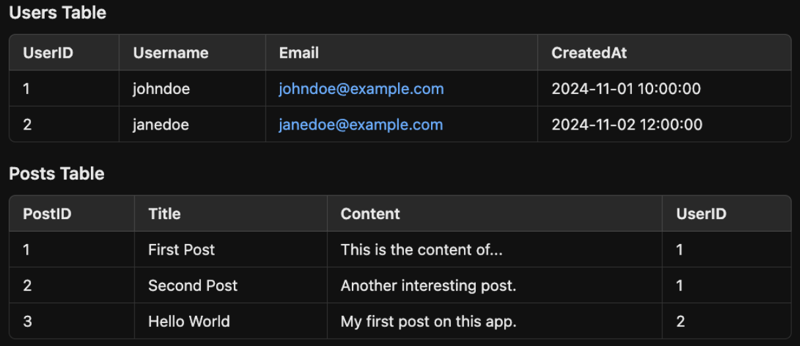 GoLang Struct
GoLang Struct
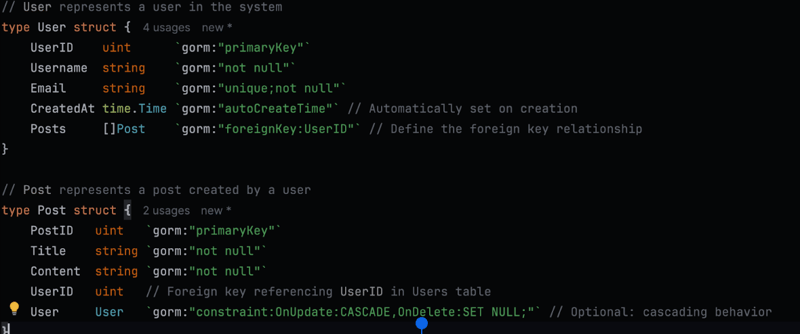 3.3 Many-to-Many Relationship
3.3 Many-to-Many Relationship


